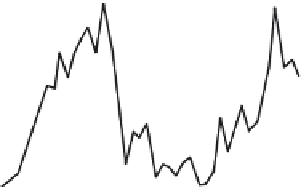Environmental Engineering Reference
In-Depth Information
Fig. 7.5
Estimated
yield-effort relation-
ships for the eastern
Atlantic yellowfi n tuna
(
Thunnus albacares
) on
the basis of data for
1964-73 (International
Commission for the
Conservation of
Atlantic Tuna (ICCAT),
1975) and 1964-83
(ICCAT, 1985). (After
Hunter et al., 1986;
Hilborn & Walters,
1992.)
81
82
78
79
76
75
77
100
83
Present
ICCAT
analysis
(1985)
80
74
72
69
68
73
71
50
(ICCAT report, 1975)
66
70
67
65
64
0
0
50
100
150
200
240
Effort (fishing days
×
1000)
Fig. 7.6
Landings of the
Peruvian anchovy since
1950. The catch crashed
in 1972 because of
overfi shing, com-
pounded by climatic
variation, and its
recovery was slow
because a moratorium
was not immediately
instituted. (After
Jennings et al., 2001.)
15
10
5
0
Year
because of overfi shing, although this was compounded by profound climatic varia-
tion. A moratorium on fi shing would have been the sensible next step, but this was
not politically feasible because so many people were dependent on the anchovy
industry for employment. So fi shing continued, albeit with smaller harvests, and
the stock took more than 20 years to recover.
A simpler way to set an MSY begins with an estimate of the carrying capacity of
a population: in bird and mammal harvests this may be an expert's opinion of
density attainable, but in the case of a fi shery it is what was present before exploita-
tion. Of course, these things are only known imperfectly, but reasonable 'guesti-
mates' can be made. Recall from Box 7.1 that with perfectly 'logistic' growth, the
MSY occurs at half of carrying capacity (0.5
K
) or half of unexploited biomass
(0.5
B
0
) Thus, the MSY quota can be set equal to the net recruitment expected when
the population size is 0.5
K
or 0.5
B
0
. This kind of rule of thumb is often used for
fi sheries, but the more conservative rule of 0.4
K
or 0.4
B
0
is usually adopted.
When the exploited population is easier to observe, other approaches are available
to set a realistic quota. In the case of moose (
Alces alces
) in Canada, for example,
aerial surveys reveal the numbers of bulls, cows and calves within a particular
management area. Not only does this provide information on population size, but
also recruitment rate. The quota of licences to shoot moose is then set to match the
current recruitment rate (after allowing for other natural mortality that will occur).
This is a sustainable yield at its most basic. On the other hand, the wildlife agency






























































Search WWH ::

Custom Search